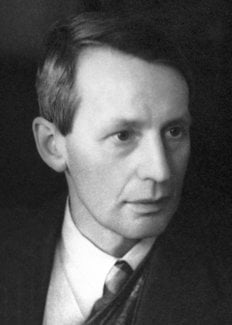George Paget Thomson
Biographical

George Paget Thomson was born in 1892 at Cambridge, the son of the late Sir J J. Thomson (then Professor of Physics at Cambridge University), a Nobel Prize winner who, more than anyone else, was responsible for the discovery of the electron, and Rose Elisabeth Paget, daughter of the late Sir George Paget, Regius Professor of Medicine at Cambridge.
George Thomson went to school in Cambridge, and then up to the University. As an undergraduate at Trinity College he took mathematics followed by physics, and had done a year’s research under his father when the 1914-1918 war broke out.
He joined the Queen’s Regiment of Infantry as a Subaltern and served for a short time in France, but returned to work on the stability of aeroplanes and other aerodynamical problems at Farnborough, and continued to work on this kind of problem at various establishments throughout the war, apart from eight months in the United States attached to the British War Mission.
After the war he spent three years as Fellow and Lecturer at Corpus Christi College, Cambridge, and continued his research on physics. He was then appointed Professor of Natural Philosophy (as physics is called in Scotland) at the University of Aberdeen, a post he held for eight years. At Aberdeen he carried out experiments on the behaviour of electrons going through very thin films of metals, which showed that electrons behave as waves in spite of being particles. For this work he later shared the Nobel Prize in Physics with C.J. Davisson of the Bell Telephone Laboratories, who had arrived at the same conclusions by a different kind of experiment. The process of electron diffraction which these experiments established to be possible has been widely used in the investigation of the surfaces of solids.
In the winter of 1929-1930 Thomson visited Cornell University, Ithaca, N.Y. as a “non-resident” lecturer. In 1930 he was appointed Professor at Imperial College in the University of London; he held this post until 1952, when he became Master of Corpus Christi College, Cambridge, retiring from the latter in 1962.
During his time at Imperial College he became interested in nuclear physics, and when the fission of uranium by neutron was discovered at the beginning of 1939 he was struck by its military and other possibilities, and persuaded the British Air Ministry to procure a ton of uranium oxide for experiments. These experiments were incomplete at the outbreak of war, when Thomson went back to the Royal Aircraft Establishment to work on a series of war problems, including magnetic mines. A year later he was made Chairman of the British Committee set up to investigate the possibilities of atomic bombs. This committee reported in 1941 that a bomb was possible, and Thomson was authorized to give this report to the American scientists Vannevar Bush and James Conant.
He spent the next year as Scientific Liaison Officer at Ottawa, and for part of this time was in close touch with the American atomic bomb effort. On returning to England he was appointed Vice-Chairman of the Radio Board and later became Scientific Adviser to the Air Ministry.
After the war he returned to work at Imperial College, and early in 1946 became interested in the possibilities of nuclear power from deuterium (heavy hydrogen). Some experiments bearing on this were started at Imperial College under Dr. Ware, but Thomson’s work was theoretical. Later, because of the requirements of secrecy, this work was transferred to the Associated Electrical Industry’s Research Laboratories at Aldermaston, where Thomson continued to act as Consultant.
Sir George T. is a Fellow of the Royal Society, and has received the Royal Medal and the Hughes Medal of that Society. He is a Doctor of Science at Cambridge, Hon. D.Sc. (Lisbon), Hon. LL.D. (Aberdeen), Hon. Sc. D. ( Dublin ), Sheffield, University of Wales and Reading. He has written a book on aerodynamics and other scientific works. His published works also include a popular book on The Atom and The Foreseeable Future, published in 1955, and The Inspiration of Science, published in 1962. He is a Foreign Member of the American Academy of Arts and Sciences and of the Lisbon Academy, and a Corresponding Member of the Austrian Academy.
In 1924 he married Kathleen Buchanan, daughter of the Very Rev. Sir George Adam Smith. They have two sons and two daughters. Ship models form part of his recreations.
This autobiography/biography was written at the time of the award and first published in the book series Les Prix Nobel. It was later edited and republished in Nobel Lectures. To cite this document, always state the source as shown above.
Sir George Paget Thomson died on September 10, 1975.
Nobel Prizes and laureates
Six prizes were awarded for achievements that have conferred the greatest benefit to humankind. The 12 laureates' work and discoveries range from proteins' structures and machine learning to fighting for a world free of nuclear weapons.
See them all presented here.
